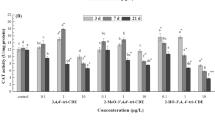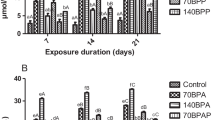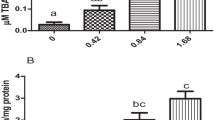Abstract
4-Nonylphenol (NP) toxicity in fish attracts much attention due to its ability in targeting several organs; however, the researches regarding its potential hepatotoxicity are conflicting and still require further investigation. Therefore, the objective of this study is to focus on this issue from the histophysiological point of view using NP intoxicated African catfish (Clarias gariepinus) as a model of hepatotoxicity. Twelve adult fish (6 per group) were divided into two groups; the first was considered as a control and the second was exposed to NP dissolved in water at a dose of 0.1 mg/kg BW for 3 weeks. A significant reduction in the hepatic alanine aminotransferase, aspartate aminotransferase, and lactate dehydrogenase levels was observed in NP-exposed fish. Concerning the oxidant/antioxidant balance, a significant depletion in superoxide dismutase, catalase, and glutathione peroxidase was found along with a significant elevation in total peroxide and malondialdhyde. The histopathological examination of the hepatic tissues revealed that NP had marked hepatotoxic effects including hepatitis, centrilobular and focal hydropic and fatty degeneration, fatty change (steatosis), hepatic coagulative necrosis, and nuclear alterations in addition to apoptosis of hepatocytes and necrosis of endothelial cells. Depletion of the glycogen and increased in pigments (lipofuscin and hemosiderin) content in the hepatocytes were also recorded. Hemosiderosis and proliferation of the connective tissue around the blood vessels and branches of bile ducts and in the portal areas were also observed. In light of these findings, it was concluded that NP has a well-defined hepatotoxic impact paving the road towards other studies to investigate other detrimental cyto-physiological influences of this aquatic pollutant.








Similar content being viewed by others
References
Abdulla Bin-Dohaish E (2012) The effects of 4-nonylphenol contamination on livers of tilapia fish (Oreochromus spilurs) in Jeddah. Biol Res 45:15–20
Aebi H (1984) Catalase in vitro. Methods Enzymol 105:121–126
AFS-FHS (2003) Suggested procedures for the detection and identification of certain finfish and shellfish pathogens, vol 5. American Fisheries Society, Bethesda
Asifa KP, Chitra KC (2016) Alteration in hepatic antioxidant defence system induced by nonylphenol in cichlid fish, Etroplus maculatus (Bloch, 1795). J Zool Stud 3:30–38
Ayala A, Muñoz MF, Argüelles S (2014) Lipid peroxidation: production, metabolism, and signaling mechanisms of malondialdehyde and 4-hydroxy-2-nonenal. Oxidative Med Cell Longev 2014:1–31
Bhattacharya H, Xiao Q, Lun L (2008) Toxicity studies of nonylphenol on rosy barb (Puntius conchonious): a biochemical and histopathological evaluation. Tissue Cell 40:243–249
Burkitt HG, Lowe J, Stevens A, Wheater PR, Young B (1996) Wheater’s basic histopathology: a colour Atlas and text. Churchill Livingstone, London, pp 88–93
Crossmon G (1937) A modification of mallorus connective tissue stain with discussion of the principle involved. Anat Rec 69:33–38
Cserháti T (1995) Alkyl ethoxylated and alkylphenol ethoxylated nonionic surfactants: interaction with bioactive compounds and biological effects. Environ Health Perspect 103:358–364
Georgakopoulou EA, Tsimaratou K, Evangelou K, Fernandez Marcos PJ, Zoumpourlis V, Trougakos IP, Kletsas D, Bartek J, Serrano M, Gorgoulis VG (2013) Specific lipofuscin staining as a novel biomarker to detect replicative and stress-induced senescence. A method applicable in cryo-preserved and archival tissues. Aging (Albany NY) 5:37–50
Gornall AG, Bardawill CJ, David MM (1949) Determination of serum protein by means of the biuret reagent. J Biol Chem 117:751–766
Gray DA, Woulfe J (2005) Lipofuscin and aging: a matter of toxic waste. Sci Aging Knowledge Environ 2005:re1
Harma M, Erel O (2005) Measurement of the total antioxidant response in preeclampsia with a novel automated method. Eur J Obstet Gynecol Reprod Biol 118:47–51. https://doi.org/10.1016/j.ejogrb.2004.04.012
Harris HF (1990) On rapid conversion of haematoxylin into haematin in staining reactions. J Appl Microsc Lab Methods 3:777
Jubendradass R, D’cruz SC, Mathur PP (2012) Long-term exposure to nonylphenol affects insulin signaling in the liver of adult male rats. Hum Exp Toxicol 31:868–876
Jung T, Bader N, Grune T (2007) Lipofuscin. Ann N Y Acad Sci 1119:97–111
Kaptaner B, Ünal G (2011) Effects of 17α-ethynylestradiol and nonylphenol on liver and gonadal apoptosis and histopathology in Chalcalburnus tarichi. Environ Toxicol 26:610–622
Karami A, Romano N, Hamzah H, Simpson SL, Yap CK (2016) Acute phenanthrene toxicity to juvenile diploid and triploid African catfish (Clarias gariepinus): molecular, biochemical, and histopathological alterations. Environ Pollut 212:155–165
Kourouma A, Keita H, Duan P, Quan C, Bilivogui KK, Qi S, Christiane NA, Osamuyimen A, Yang K (2015) Effects of 4-nonylphenol on oxidant/antioxidant balance system inducing hepatic steatosis in male rat. Toxicol Rep 2:1423–1433
Kumar N, Sharma R, Tripathi G, Kumar K, Dalvi RS, Krishna G (2016) Cellular metabolic, stress, and histological response on exposure to acute toxicity of endosulfan in tilapia (Oreochromis mossambicus). Environ Toxicol 31:106–115
Kumari K, Ranjan N, Sinha RC (2011) Multiple biomarker response in the fish, Labeo Rohita due to hexavalent chromium. In: proceedings of the 2nd International Conference on Biotechnology and Food Science (IPCBEE’11) (vol 7). IACSIT Press
Liao CY, Fu JJ, Shi JB, Zhou QF, Yuan CG, Jiang GB (2006) Methylmercury accumulation, histopathology effects, and cholinesterase activity alterations in medaka (Oryzias latipes) following sublethal exposure to methylmercury chloride. Environ Toxicol Pharmacol 22:225–233
Matozzo V, Ballarin L, Marin MG (2004) Exposure of the clam Tapes philippinarum to 4-nonylphenol: changes in anti-oxidant enzyme activities and re-burrowing capability. Mar Pollut Bull 48:563–571
McManus JFA (1946) Histological demonstration of mucin after periodic acid. Nature 158:202
Mekkawy IA, Mahmoud UM, Sayed Ael D (2011) Effects of 4-nonylphenol on blood cells of the African catfish Clarias gariepinus (Burchell, 1822). Tissue Cell 43:223–229. https://doi.org/10.1016/j.tice.2011.03.006
Midhila EM, Chitra KC (2015) Nonylphenol induced hepatotoxicity in the freshwater fish Oreochromis mossambicus. Int J Sci Res Publ 5:1–5
Nishikimi M, Rao NA, Yagi K (1972) The occurrence of superoxide anion in the reaction of reduced phenazine methosulfate and molecular oxygen. Biochem Biophys Res Commun 46:849–854
Ohkawa H, Ohishi N, Yagi K (1979) Assay for lipid peroxides in animal tissues by thiobarbituric acid reaction. Anal Biochem 95:351–358
Okai Y, Higashi-Okai K, Machida K, Nakamura H, Nakayama K, Fujita KI, Tanaka T, Otani S, Taniguchi M (2000) Protective effect of antioxidants against para-nonylphenol-induced inhibition of cell growth in Saccharomyces cerevisiae. FEMS Microbiol Lett 185:65–70
Paglia DE, Valentine WN (1967) Studies on the quantitative and qualitative characterization of erythrocyte glutathione peroxidase. J Lab Clin Med 70:158–169
Park KH (2015) Alteration of hepatic anti-oxidant systems by 4-nonylphenol, a metabolite of alkylphenol polyethoxylate detergents, in far eastern catfish Silurus Asotus. Environ Health Toxicol 30:e2015006. https://doi.org/10.5620/eht.e2015006
Ramalingam V, Rajaram R (2016) Antioxidant activity of 1-hydroxy-1-norresistomycin derived from Streptomyces variabilis KP149559 and evaluation of its toxicity against zebra fish Danio rerio. RSC Adv 6:16615–16623
Rivero CL, Barbosa AC, Ferreira MF, Dorea JG, Grisolia CK (2008) Evaluation of genotoxicity and effects on reproduction of nonylphenol in Oreochromis niloticus (Pisces: Cichlidae). Ecotoxicology 17:732–737. https://doi.org/10.1007/s10646-008-0222-0
Sayed AH, Hamed HS (2017) Induction of apoptosis and DNA damage by 4-nonylphenol in African catfish (Clarias gariepinus) and the antioxidant role of Cydonia oblonga. Ecotoxicol Environ Saf 139:197–101
Sayed AH, Mekkawy IA, Mahmoud UM (2012) Histopathological alterations in some body organs of adult Clarias gariepinus (Burchell, 1822) exposed to 4-nonylphenol. In: Zoology. InTech
Shairibha SM, Rajadurai M (2014) Ant-diabetic effect of p-coumaric acid on lipid peroxidation, antioxidant status and histopathological examinations in streptozotocin-induced diabetic rats. Int J Integr Sci Innov Technol Section B Appl Technol Sci 3:1–11
Shoko AP, Limbu SM, Mrosso HDJ, Mkenda AF, Mgaya YD (2016) Effect of stocking density on growth, production and economic benefits of mixed sex Nile tilapia (Oreochromis niloticus) and African sharptooth catfish (Clarias gariepinus) in polyculture and monoculture. Aquac Res 47:36–50
Sikora E, Arendt T, Bennett M, Narita M (2011) Impact of cellular senescence signature on ageing research. Ageing Res Rev 10:146–152
Spurr AR (1969) A low-viscosity epoxy resin embedding medium for electron microscopy. J Ultrastruct Res 26:31–43
Stark GJ (2005) Functional consequences of oxidative membrane damage. J Membr Biol 205:1–16
Stevens A (1986) Theory and practice of histological techniques. In: Bancroft JD, Stevens A (eds) Pigments and minerals. Churchill Livingstone, Edinburgh, pp 258–262
Uguz C, Iscan M, Ergüven A, Isgor B, Togan I (2003) The bioaccumulation of nonyphenol and its adverse effect on the liver of rainbow trout (Onchorynchus mykiss). Environ Res 92:262–270
Vazquez-duhalt R, Marquez-rocha F, Ponce E, Licea AF, Viana MT (2005) Nonylphenol, an intergrated vision of a pollutant. Scientific review. Appl Ecol Env Res 4: 1-25
Wu Y, Zhou Q (2013) Silver nanoparticles cause oxidative damage and histological changes in medaka (Oryzias latipes) after 14 days of exposure. Environ Toxicol Chem 32:165–173
Wu M, Xu H, Shen Y, Qiu W, Yang M (2011) Oxidative stress in zebrafish embryos induced by short-term exposure to bisphenol A, nonylphenol, and their mixture. Environ Toxicol Chem 30:2335–2341
Xu H, Yang M, Qiu W, Pan C, Wu M (2013) The impact of endocrine-disrupting chemicals on oxidative stress and innate immune response in zebrafish embryos. Environ Toxicol Chem 32:1793–1799. https://doi.org/10.1002/etc.2245
Zha J, Wang Z, Wang N, Ingersoll C (2007) Histological alternation and vitellogenin induction in adult rare minnow (Gobiocypris rarus) after exposure to ethynylestradiol and nonylphenol. Chemosphere 66:488–495
Author information
Authors and Affiliations
Corresponding author
Electronic supplementary material
Supplementary Fig. 1
Photomicrograph of paraffin sections illustrated the hepatotoxic effects of NP on Clarias gariepinus. a Showed congested blood vessels (C), inflammatory leucocytic infiltrations (L), and melanomacrophage center (MMC). b Showed congested blood vessels (C), inflammatory leucocytic infiltrations near the melanomacrophage center (MMC), and coagulative necrosis (CN). Original magnification, a, b × 200, scale bar = 100 μm, Hematoxylin and Eosin stain (GIF 176 kb)
Supplementary Fig. 2
Photomicrograph of paraffin sections illustrated the hepatotoxic effects of NP on Clarias gariepinus. a Showed apoptotic hepatocyte (arrow head) and melanomacrophage centers (MMC) which were formed of aggregates of macrophages (arrow) filled with pigments (brown color). b Showed hyalinized blood vessels (HBV), endothelial cells of blood vessels (arrow head), degenerated blood vessel (DBV), necrotic endothelial cells of blood vessels (arrow), and hepatocyte filled with lipofuscin pigments (forked tail arrow). Original magnification, a, b × 400, scale bar = 50 μm, Hematoxylin and Eosin stain (GIF 207 kb)
Rights and permissions
About this article
Cite this article
Abd-Elkareem, M., Abou Khalil, N.S. & Sayed, A.H. Hepatotoxic responses of 4-nonylphenol on African catfish (Clarias gariepinus): antixoidant and histochemical biomarkers. Fish Physiol Biochem 44, 969–981 (2018). https://doi.org/10.1007/s10695-018-0485-1
Received:
Accepted:
Published:
Issue Date:
DOI: https://doi.org/10.1007/s10695-018-0485-1




